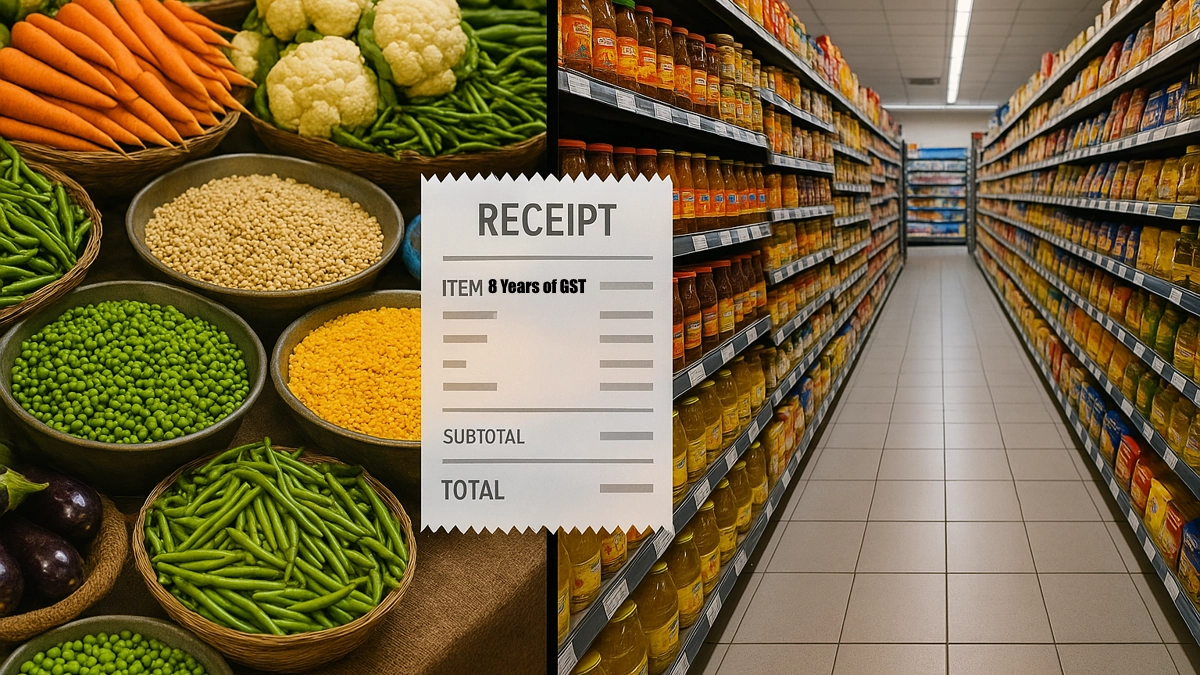Eight years ago today, India embarked on its most ambitious tax reform, introducing the Goods and Services Tax (GST) with the promise of “One Nation, One Tax.” The goal was to simplify a complex web of taxes like VAT, Service Tax, and Excise Duty, creating a single market to boost business and benefit consumers. Now, in 2025, as we mark the 8th GST Day, it’s time to look past the policy debates and ask a simple question: How has it actually changed your family’s budget?
The answer isn’t a simple “cheaper” or “costlier.” The impact of GST on your wallet has been a mixed bag, deeply dependent on what you buy and the services you use. Let’s break it down with the data.
The Big Picture: A More Formal and Buoyant Economy
Before diving into your kitchen expenses, it’s important to see the national impact. GST has been a resounding success in formalizing the economy.
- Massive Growth in Taxpayers: The number of businesses registered under GST has surged from about 6 million in 2017 to over 1.51 crore (15.1 million) as of April 2025.
- Record Revenue: GST collections have shown remarkable growth, hitting a record ₹22.08 lakh crore in the financial year 2024-25. Just in May 2025, collections stood at an impressive ₹2.01 lakh crore, signaling strong economic activity.
This robust collection means more funds for public infrastructure and services. But how did this translate to your household?
Your Shopping Cart: A Tale of Two Halves
GST’s impact is most visible when you look at your daily shopping list.
What Became Cheaper (or stayed neutral):
- Basic Food Items: Unbranded and unpackaged staples like fresh vegetables, fruits, milk, cereals, and common salt remain exempt from GST, just as they were largely untaxed before. This has helped keep the cost of a basic food plate stable.
- Some FMCG Goods: Daily-use items like hair oil, soaps, and toothpaste saw a reduction in the overall tax burden, moving from a pre-GST effective rate of ~24-25% to a standard 18% slab, which helped control their prices.
- Dining Out (in most cases): The GST on restaurant services was simplified. For most standalone restaurants, the tax is a flat 5% (without input tax credit), which is lower than the multiple taxes applied before 2017.
What Became More Expensive:
- Packaged and Branded Foods: The moment you opt for pre-packaged and labelled versions of items like curd, paneer, honey, and wheat flour, a 5% GST kicks in. These were previously exempt.
- Household Appliances: Items like mixers, fans, and refrigerators generally fall under the 18% or 28% slabs, making them slightly costlier than in the pre-GST era for many states.
- Services – The Biggest Pinch: This is where most households felt the increase. Services like telecom bills, banking charges, and insurance premiums moved from a 15% service tax to a standard 18% GST. This 3% jump directly increased monthly expenses for millions.
The Hidden Gains and Lingering Pains
Beyond the price tags, GST brought systemic changes that indirectly affect your budget.
- Gains from Efficiency: The removal of state border check-posts has drastically cut down transport time for goods by over 30%. This efficiency reduces logistics costs for companies, a benefit that, while not always visible, helps to keep product prices from rising further.
- The Unresolved Pains: Key items like petrol, diesel, and electricity still remain outside the GST ambit. Their prices are determined by central and state taxes, meaning a major component of your household and transport budget hasn’t received the benefit of a uniform tax structure. Experts widely agree that bringing these sectors into GST is the next major step needed for the reform.
After eight years, GST has fundamentally reshaped India’s economic landscape. For the average household, it has brought transparency and has stabilized or reduced the cost of basic goods. However, the increased cost of essential services and the exclusion of fuel mean that for many families, the jury is still out on whether their budget is truly better off. As the system continues to evolve, the focus remains on further simplification and broadening the tax base to truly fulfill the ‘One Nation, One Tax’ promise for every citizen.




